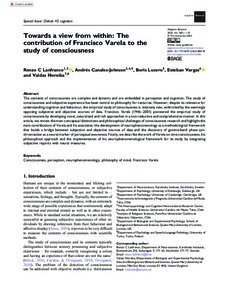Towards a view from within: The contribution of Francisco Varela to the study of consciousness
Lanfranco Renzo C; Canales-Johnson Andres; Lucero Boris; Vargas Esteban; Noreika Valdas
Towards a view from within: The contribution of Francisco Varela to the study of consciousness
Lanfranco Renzo C
Canales-Johnson Andres
Lucero Boris
Vargas Esteban
Noreika Valdas
SAGE PUBLICATIONS LTD
Julkaisun pysyvä osoite on:
https://urn.fi/URN:NBN:fi-fe2022081154648
https://urn.fi/URN:NBN:fi-fe2022081154648
Tiivistelmä
The contents of consciousness are complex and dynamic and are embedded in perception and cognition. The study of consciousness and subjective experience has been central to philosophy for centuries. However, despite its relevance for understanding cognition and behaviour, the empirical study of consciousness is relatively new, embroiled by the seemingly opposing subjective and objective sources of data. Francisco Varela (1946-2001) pioneered the empirical study of consciousness by developing novel, naturalised and rich approaches in a non-reductive and comprehensive manner. In this article, we review the main conceptual distinctions and philosophical challenges of consciousness research and highlight the main contributions of Varela and his associates: the development of neurophenomenology as a methodological framework that builds a bridge between subjective and objective sources of data and the discovery of gamma-band phase synchronisation as a neural marker of perceptual awareness. Finally, we describe the work of Varela on time consciousness, his philosophical approach and the implementation of his neurophenomenological framework for its study by integrating subjective reports with neural measures.
Kokoelmat
- Rinnakkaistallenteet [27094]
